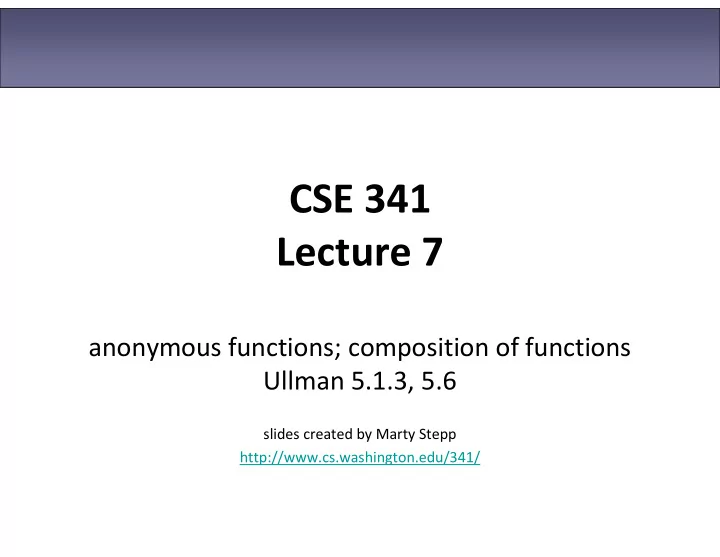

CSE 341 Lecture 7 anonymous functions; composition of functions Ullman 5.1.3, 5.6 slides created by Marty Stepp http://www.cs.washington.edu/341/
Review: operator -- • Define an operator min -- max that will produce a list of the integers in the range [ min , max ] inclusive. � Example: 2--7 produces [2,3,4,5,6,7] (We'll use -- as a helper for several later examples.) • Solution: infix --; fun min -- max = if min > max then [] else min :: ((min+1) -- max); �
Anonymous functions (5.1.3) fn parameter(s) => expression • Example: - map(fn x => x+1, [2, 0, 9, ~3]); val it = [3,1,10,~2] : int list • allows you to define a function without giving it a name • useful with higher-order functions e.g. map/filter/reduce • fun name... is the same as val name = fn... �
Pascal's triangle exercise • Pascal's triangle is a sequence of numbers of the form: 1 1 1 1 2 1 1 3 3 1 1 4 6 4 1 1 5 10 10 5 1 • Define a function triangle that takes an integer n and produces a list of the first n levels of the triangle. � triangle(6) produces [[1], [1,1], [1,2,1], [1,3,3,1], [1,4,6,4,1], [1,5,10,10,5,1]] �
Pattern of numbers • The values at the two ends of a row are always 1. • An interior number is the sum of the two values above it: � value at (row n , col k ) = value at ( n -1, k -1) + value at ( n -1, k ) row col 1 2 3 4 5 6 1 1 1 2 1 1 1 1 3 1 2 1 1 2 1 4 1 3 3 1 1 3 3 1 5 1 4 6 4 1 1 4 6 4 1 6 1 5 10 10 5 1 1 5 10 10 5 1 � Can we turn these observations into a helping function? �
Binomial coefficients • the numbers in Pascal's triangle also relate to binomial coefficients, or " n choose k " combinations: • Use the following function as a helper: (* returns n choose k *) fun combin(n, k) = if k = 0 orelse k = n then 1 else if k = 1 then n else combin(n - 1, k - 1) + combin(n - 1, k); �
The triangle function • The overall triangle consists of rows of the form: � [ r choose 1, r choose 2, ..., r choose r ] • To produce a triangle of n levels: � for each number r in the range 1 through n , – for each number k in the range 1 through r , – compute ( r choose k ). put all such values together into a list. �
triangle solution (* Returns level r of Pascal's triangle (1-based). *) fun makeRow(r) = let fun rChoose(k) => combin(r, k) in map(rChoose, 1--r) end; (* Returns the first n levels of Pascal's triangle. *) fun triangle(n) = map(makeRow, 1--n); (* Version that uses anonymous functions *) fun triangle(n) = map( fn(r) => map( fn(k) => combin(r, k) , 1--r), 1--n); �
Exercise • Write an ML expression that produces the square roots of the integers from 1-100, rounded to the nearest integer. � Write it as a one-line expression without let or fun . [1,1,2,2,2,2,3,3,3,3,3,3,4,4,4,4,4,4,4,4,5,5,5,5,5,5,5,5,5,5,6,6,6,6,6,6,6, 6,6,6,6,6,7,7,7,7,7,7,7,7,7,7,7,7,7,7,8,8,8,8,8,8,8,8,8,8,8,8,8,8,8,8,9,9,9 ,9,9,9,9,9,9,9,9,9,9,9,9,9,9,9,10,10,10,10,10,10,10,10,10,10] : int list • Solution: map(fn(n) => round(Math.sqrt(real(n))), 1--100); �
Composing functions (5.6) • The preceding code is really just a combination ( composition ) of other existing functions. � round(Math.sqrt(real(n))) • Consider the following function. How could we use it? (* Produces a new function H that calls G and F. *) fun compose(F, G) = let fun H(x) = F(G(x)) in H end; ��
Composition operator, o (5.6.2) function1 o function2 • the o operator is similar to our compose function � val H = F o G; produces a new function H such that H(x) = F(G(x)) • function composition is so important that most functional languages include a convenient syntax for it ��
Composition exercise • Write an ML expression that produces the square roots of the integers from 1-100, rounded to the nearest integer. � Use function composition with the o operator. • Solution: map( round o Math.sqrt o real , 1--100); ��
Composition exercise • Define a function squareWhole that takes a list of reals and produces the squares of their integer portions. � (a one-liner using composition and higher-order functions) � Example: squareWhole([3.4, 1.7, 5.8, 10.6]) produces [9.0,1.0,25.0,100.0] • Solution: fun squareWhole(lst) = map(real o (fn(x) => x*x) o trunc, lst); ��
Recommend
More recommend